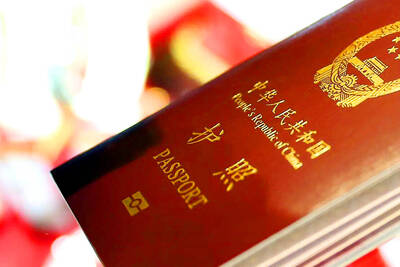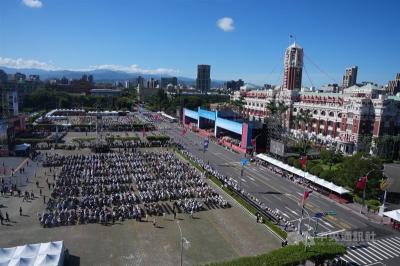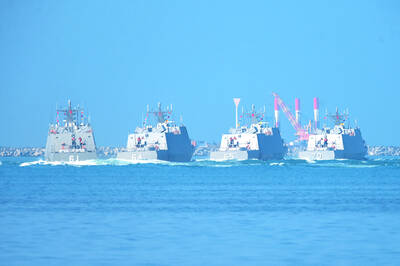Secretary of State Condoleezza Rice and her spokesmen were evasive Friday when asked about reports that the US and Japan will announce Saturday that they jointly regard Taiwan as a mutual security concern, a move seen as potentially committing both countries to act in the event of a Chinese attack on Taiwan.
The plan was first revealed in the Friday edition of the Washington Post in a report from Tokyo.
The Post report said that in the most significant change to the US-Japan Security Alliance in a decade, "Japan will join the Bush administration in identifying security in the Taiwan Strait as a `common strategic objective.'"
The decision is scheduled to be announced, the report said, after a meeting in Washington of the two countries' foreign and defense ministers -- ? Rice, Defense Secretary Donald Rumsfeld, Foreign Minister Nobutaka Machimura and Minister of State for Defense Yoshinori Ono.
Rice and Machimura were to hold a half-hour bilateral meeting yesterday morning followed by a meeting of all four officials constituting the US-Japan Security Consultative Committee. It is the first meeting of the consultative organization since Dec. 16, 2002.
Asked Friday about the meeting and the report, Rice said only that the discussion will be about "how we continue to promote peace and security in the region."
"Of course, the cross-straits [sic] issue is an issue of concern in the Asia Pacific," Rice said. "The policy of the US is quite clear. We have a one-China policy we recognize on the basis of the three communiques. We also have responsibilities under the Taiwan Relations Act."
She also said Washington has cautioned both sides against attempts to change the status quo unilaterally.
"And our efforts to maintain stability in the region count very much on American adherence and that of our allies, of which Japan is certainly an ally, that the cross-straits [sic] problem would be resolved peacefully," Rice said, in response to a reporter's question during a press conference with Dutch foreign minister Bernard Bot in the State Department.
She also said that the US and Japan "enjoy very deep and broad relations in an alliance to try and help bring and maintain peace and stability in the Asia Pacific region."
State Department spokesman Richard Boucher said that yesterday's meeting "will have a full and complete discussion of security in the region, as well as US-Japan relations."
"We are not extending the US-Japan Mutual Security Treaty," Boucher insisted. "We're having discussions within the scope of that treaty about areas in the region ... and more generally in terms of our interests there."
In terms of individual issues, Boucher said "Taiwan Straits [sic], perhaps, will come up." Pressed about what Japan may do, Boucher retorted, "as far as issues of what exact role they play depends on the Japanese government, and they'll have to answer those."
The Washington Post report quotes Japanese officials as noting that the country's constitution limits the level of assistance that Japan could offer in the event of a US confrontation with China over Taiwan.
However, it says yesterday's joint statement "could help lay the groundwork for the Japanese to extend as much cooperation as they legally can, including logistical support such as transportation and medical rescue operations behind the lines of combat."
It also quotes Shinzo Abe, the acting secretary general of Japan's ruling Liberal Democratic Party as saying, "It would be wrong for us to send a signal to China that the US and Japan will watch and tolerate China's military invasion of Taiwan."
"If the situation surrounding Japan threatens our security, Japan can provide US forces with support," Abe was quoted as saying.
The US-Japan meeting comes as Tokyo is reconsidering its defense posture and the use of its self-defense forces, and as Washington is rethinking its force posture in East Asia to put more reliance on such allies as Japan.
This week, the Japanese Cabinet approved and sent to the Diet a bill to ease the rules for using missile defense against incoming ballistic missiles.
Such a defense would employ warships equipped with the Aegis missile interception system and PAC 3 surface-to-air missiles.
While Taiwan's Legislative Yuan is still dealing with whether to approve funds for a massive US arms sales deal including the PAC 3's, Washington has refused to sell the Aegis-equipped warships to Taiwan in deference to China's objections.
Under current law, Japan cannot send its Aegis vessels to the Taiwan Strait area to come to Taiwan's defense, but Tokyo has been involved in an internal debate in recent years over whether or not to relax that restriction.
Also see stories:

The Ministry of the Interior (MOI) is to tighten rules for candidates running for public office, requiring them to declare that they do not hold a Chinese household registration or passport, and that they possess no other foreign citizenship. The requirement was set out in a draft amendment to the Enforcement Rules of the Public Officials Election and Recall Act (公職人員選舉罷免法 ) released by the ministry on Thursday. Under the proposal, candidates would need to make the declaration when submitting their registration forms, which would be published in the official election bulletin. The move follows the removal of several elected officials who were

The Republic of China (ROC) is celebrating its 114th Double Ten National Day today, featuring military parades and a variety of performances and speeches in front of the Presidential Office in Taipei. The Taiwan Taiko Association opened the celebrations with a 100-drummer performance, including young percussionists. As per tradition, an air force Mirage 2000 fighter jet flew over the Presidential Office as a part of the performance. The Honor Guards of the ROC and its marching band also heralded in a military parade. Students from Taichung's Shin Min High School then followed with a colorful performance using floral imagery to represent Taiwan's alternate name

FOUR DESIGNATED AREAS: Notices were issued for live-fire exercises in waters south and northwest of Penghu, northeast of Keelung and west of Kaohsiung, they said The military is planning three major annual exercises across the army, navy and air force this month, with the navy’s “Hai Chiang” (海強, “Sea Strong”) drills running from today through Thursday, the Ministry of National Defense said yesterday. The Hai Chiang exercise, which is to take place in waters surrounding Taiwan, would feature P-3C Orion maritime patrol aircraft and S-70C anti-submarine helicopters, the ministry said, adding that the drills aim to bolster the nation’s offshore defensive capabilities. China has intensified military and psychological pressure against Taiwan, repeatedly sending warplanes and vessels into areas near the nation’s air defense identification zone and across

A Chinese takeover of Taiwan would severely threaten the national security of the US, Japan, the Philippines and other nations, while global economic losses could reach US$10 trillion, National Security Council Deputy Secretary-General Lin Fei-fan (林飛帆) wrote in an article published yesterday in Foreign Affairs. “The future of Taiwan is not merely a regional concern; it is a test of whether the international order can withstand the pressure of authoritarian expansionism,” Lin wrote in the article titled “Taiwan’s Plan for Peace Through Strength — How Investments in Resilience Can Deter Beijing.” Chinese President Xi Jinping’s (習近平) intent to take Taiwan by force